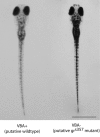A zebrafish model of glucocorticoid resistance shows serotonergic modulation of the stress response
- PMID: 23087630
- PMCID: PMC3468897
- DOI: 10.3389/fnbeh.2012.00068
A zebrafish model of glucocorticoid resistance shows serotonergic modulation of the stress response
Abstract
One function of glucocorticoids is to restore homeostasis after an acute stress response by providing negative feedback to stress circuits in the brain. Loss of this negative feedback leads to elevated physiological stress and may contribute to depression, anxiety, and post-traumatic stress disorder. We investigated the early, developmental effects of glucocorticoid signaling deficits on stress physiology and related behaviors using a mutant zebrafish, gr(s357), with non-functional glucocorticoid receptors (GRs). These mutants are morphologically inconspicuous and adult-viable. A previous study of adult gr(s357) mutants showed loss of glucocorticoid-mediated negative feedback and elevated physiological and behavioral stress markers. Already at 5 days post-fertilization, mutant larvae had elevated whole body cortisol, increased expression of pro-opiomelanocortin (POMC), the precursor of adrenocorticotropic hormone (ACTH), and failed to show normal suppression of stress markers after dexamethasone treatment. Mutant larvae had larger auditory-evoked startle responses compared to wildtype sibling controls (gr(wt)), despite having lower spontaneous activity levels. Fluoxetine (Prozac) treatment in mutants decreased startle responding and increased spontaneous activity, making them behaviorally similar to wildtype. This result mirrors known effects of selective serotonin reuptake inhibitors (SSRIs) in modifying glucocorticoid signaling and alleviating stress disorders in human patients. Our results suggest that larval gr(s357) zebrafish can be used to study behavioral, physiological, and molecular aspects of stress disorders. Most importantly, interactions between glucocorticoid and serotonin signaling appear to be highly conserved among vertebrates, suggesting deep homologies at the neural circuit level and opening up new avenues for research into psychiatric conditions.
Keywords: SSRI; anxiety; depression; glucocorticoid receptors; stress; zebrafish.
Figures






Similar articles
-
An affective disorder in zebrafish with mutation of the glucocorticoid receptor.Mol Psychiatry. 2013 Jun;18(6):681-91. doi: 10.1038/mp.2012.64. Epub 2012 May 29. Mol Psychiatry. 2013. PMID: 22641177 Free PMC article.
-
Profound effects of glucocorticoid resistance on anxiety-related behavior in zebrafish adults but not in larvae.Gen Comp Endocrinol. 2020 Jun 1;292:113461. doi: 10.1016/j.ygcen.2020.113461. Epub 2020 Mar 17. Gen Comp Endocrinol. 2020. PMID: 32194047
-
nr3c1 null mutant zebrafish are viable and reveal DNA-binding-independent activities of the glucocorticoid receptor.Sci Rep. 2017 Jun 29;7(1):4371. doi: 10.1038/s41598-017-04535-6. Sci Rep. 2017. PMID: 28663543 Free PMC article.
-
The zebrafish stress axis: molecular fallout from the teleost-specific genome duplication event.Gen Comp Endocrinol. 2009 Mar;161(1):62-6. doi: 10.1016/j.ygcen.2008.09.011. Epub 2008 Oct 1. Gen Comp Endocrinol. 2009. PMID: 18930731 Review.
-
How to measure glucocorticoid receptor's sensitivity in patients with stress-related psychiatric disorders.Psychoneuroendocrinology. 2018 May;91:235-260. doi: 10.1016/j.psyneuen.2018.01.023. Epub 2018 Feb 2. Psychoneuroendocrinology. 2018. PMID: 29449045 Review.
Cited by
-
Optogenetic elevation of endogenous glucocorticoid level in larval zebrafish.Front Neural Circuits. 2013 May 6;7:82. doi: 10.3389/fncir.2013.00082. eCollection 2013. Front Neural Circuits. 2013. PMID: 23653595 Free PMC article.
-
Homeostatic Regulation of Glucocorticoid Receptor Activity by Hypoxia-Inducible Factor 1: From Physiology to Clinic.Cells. 2021 Dec 7;10(12):3441. doi: 10.3390/cells10123441. Cells. 2021. PMID: 34943949 Free PMC article. Review.
-
Developing highER-throughput zebrafish screens for in-vivo CNS drug discovery.Front Behav Neurosci. 2015 Feb 12;9:14. doi: 10.3389/fnbeh.2015.00014. eCollection 2015. Front Behav Neurosci. 2015. PMID: 25729356 Free PMC article.
-
High-resolution tracking of unconfined zebrafish behavior reveals stimulatory and anxiolytic effects of psilocybin.Mol Psychiatry. 2024 Apr;29(4):1046-1062. doi: 10.1038/s41380-023-02391-7. Epub 2024 Jan 17. Mol Psychiatry. 2024. PMID: 38233467 Free PMC article.
-
Glucocorticoid-Responsive Transcription Factor Krüppel-Like Factor 9 Regulates fkbp5 and Metabolism.Front Cell Dev Biol. 2021 Oct 6;9:727037. doi: 10.3389/fcell.2021.727037. eCollection 2021. Front Cell Dev Biol. 2021. PMID: 34692682 Free PMC article.
References
-
- Abramoff M. D., Magalhaes P. J., Ram S. J. (2004). Image processing with imageJ. Biophotonics Int. 11, 36–42
Grants and funding
LinkOut - more resources
Full Text Sources
Molecular Biology Databases
Miscellaneous

